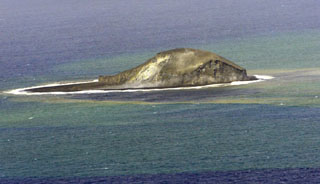Report on Home Reef (Tonga) — July 1984
Scientific Event Alert Network Bulletin, vol. 9, no. 7 (July 1984)
Managing Editor: Lindsay McClelland.
Home Reef (Tonga) Large pumice rafts in Fiji area from March eruption
Please cite this report as:
Global Volcanism Program, 1984. Report on Home Reef (Tonga) (McClelland, L., ed.). Scientific Event Alert Network Bulletin, 9:7. Smithsonian Institution. https://doi.org/10.5479/si.GVP.SEAN198407-243080
Home Reef
Tonga
18.992°S, 174.775°W; summit elev. -10 m
All times are local (unless otherwise noted)
Large rafts of floating pumice probably from the early March eruption of Home Reef were reported in the Fiji area through early July. The press reported that pumice was first sighted in waters near the Lau island group (roughly 400 km WNW of Home Reef) in April. By early May, large pumice rafts in several regions of Fiji were forcing ships to return to port, and pumice covered the shoreline of many islands. The Fiji press also reported that pumice had reached Vanuatu and the Solomon Islands by early May. From a ship on 2 May, David Tappin observed pumice rafts about 100 m long and 20 m wide just outside the harbor at Suva (Fiji's capital, about 750 km WNW of Home Reef). Flying from Suva to Tonga on 12 May, Tappin saw 5-10 similar en echelon rafts between Suva and about 19°S that appeared to be moving WNW or W. A large kill of deep-sea fish was reported at Oni-i-Lau (at the south end of the Lau islands) at the end of May. Thick layers of pumice had accumulated at the shoreline, strong enough to support the weight of adults. Tides and winds carried a thick blanket of pumice into Suva harbor 24 June, but officials said that by then there was less pumice in the Fiji area than in April.
Geological Summary. Home Reef, a submarine volcano midway between Metis Shoal and Late Island in the central Tonga islands, was first reported active in the mid-19th century, when an ephemeral island formed. An eruption in 1984 produced a 12-km-high eruption plume, large amounts of floating pumice, and an ephemeral 500 x 1,500 m island, with cliffs 30-50 m high that enclosed a water-filled crater. In 2006 an island-forming eruption produced widespread dacitic pumice rafts that drifted as far as Australia. Another island was built during a September-October 2022 eruption.
Information Contacts: P. Rodda, Mineral Resources Dept., Fiji; D. Tappin, Ministry of Lands, Survey, and Natural Resources, Tonga; R. Krishna, Fiji Meteorological Service; Fiji Times.

